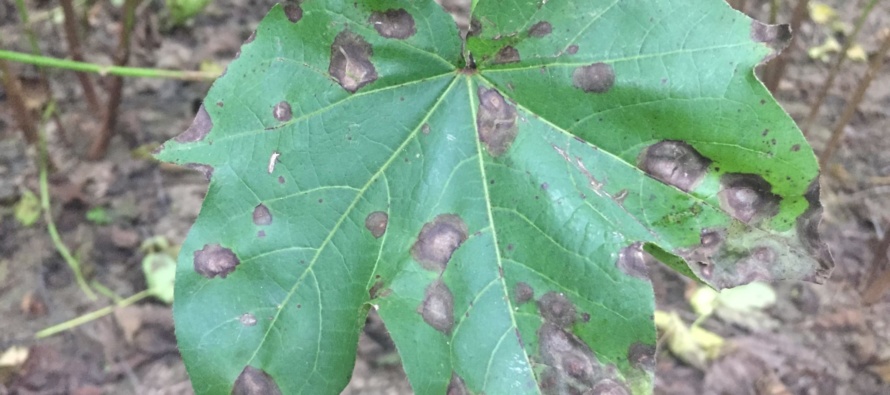Cotton Target Spot: 2017 Lucedale OVT Disease Rating Results

Related Articles
- 2010 Soybean And Corn Variety Trial Data 3
- Rice Variety Trial Results For 2010, Plus Rice Research Report 0
- Evaluation of Peanut Varieties in Mississippi, 2010 0
Latest Tweets
Target spot continues to be a hot discussion topic this winter. Lots of questions regarding what fungicide treatments work (not much looks positive here) and which varieties may appear to tolerant to the disease. During 2017, a set of the cotton variety trial was planted in Lucedale, MS. Lucedale was chosen as an area where severe target spot has been more regularly observed due to the increased humidity and general rainfall pattern during the summer months.
2017 Lucedale target spot OVT trial table
Target spot disease observations
Disease observations (or ratings) for target spot can be difficult to conduct. Not only is disease present on leaves and other plant parts (bracts, bolls, petioles, stems) throughout the canopy, but the defoliation as a result of disease can be severe. Assessing percent defoliation could help determine whether a variety is susceptible or resistant. Moreover, defoliation likely has an impact on yield. Observations in Lucedale were made on the presence of disease on leaves and are indicated in the associated table as a percent incidence (percent leaf tissue exhibiting symptoms) and severity (percent leaf tissue covered). In addition to observations of target spot on leaves, defoliation observations in the form of percent defoliation (from the bottom of the plant looking through the canopy) were also made.
In addition to the disease observations from leaf tissue, incidence and severity of boll shed was evaluated. Numerous individuals have attempted to “link” (albeit with no evidence) boll shed to the severity of target spot. In most instances where boll shed was observed during the 2016 and 2017 seasons an extended period of cloudy, humid, cool weather prevailed. Based on the observations made in Lucedale, 12 plots presented situations whereby a boll or more than one boll was observed on the ground. However, in the instances observed an extremely limited number of bolls were observed on the ground. The incidence and severity of target spot as well as the defoliation observed in these specific plots greatly varied and no associated correlations were evident, therefore those data are not presented. In addition, none of the varieties had more than one plot with bolls observed on the ground. Based on the severity of the disease in some of the plots observed, making statements regarding boll shed as a result of target spot are difficult. Plant pathologists in the southeastern U.S. (south AL and GA) suggest that boll shed as a result of target spot has not been observed. The boll shed observed during 2016 and 2017 is more likely to have been associated with the prevailing environment which in most cases would be considered to be poor for proper physiological development of cotton.
Defoliation as a result of target spot

Defoliation categories as created based on the Lucedale OVT data. Bold numbers on each bar indicate the number of varieties within a given category. The minimum and maximum yield values for the varieties within each category are at the top of the figure in the table.
One way to look at data from Lucedale is to consider the response of varieties within defoliation categories (or frequency within a given category). By grouping varieties within classes, based on ranges of defoliation, one would hope to gather some valuable information regarding the response of varieties that were observed to perform in a similar fashion. To this end, five defoliation categories based on percent defoliation (0-10, 10-20, 20-30, 30-40, 40-50) were assigned based on the observations of all 52 varieties. Based on defoliation averages (from all four plots of a given variety) the lowest percent defoliation observed was 2.3%, while the greatest observed was 48.7%. The average of all varieties was 30.8%. However, take the information in the associated figure with a grain of salt. In some cases, the range of yield between varieties in the assigned classes can be quite large. The minimum and maximum yield for the varieties in each classification are presented in the table at the top of the figure. Based on these data (one year, one location) it is difficult to make assumptions with a limited number of observations, in this case varieties, within a given classification. The number of varieties within each defoliation category are included as the bold number on each bar. However, if yield can be related to defoliation based on these classifications it appears that some varieties are more tolerant than others. But, with all of that said, more observations are necessary to determine the differences between target spot susceptible and target spot resistant varieties.






Let me tell You a sad story ! There are no comments yet, but You can be first one to comment this article.
Write a comment